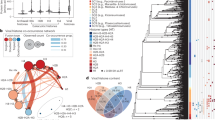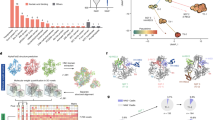Abstract
In African trypanosomes, antigenic variation is achieved through differential gene activation, with one antigen gene being expressed at a time among a large collection of antigen-specific sequences. Transcription of the antigen gene always takes place in a telomere, but different telomeres can alternatively act as the expression site1–4. Telomeric antigen genes can be expressed without apparent DNA rearrangement5–8, but they can also, like non-telomeric genes, have access to the telomeric expression site through a duplicative transposition mechanism resembling gene conversion7–10. We report here that, as previously suggested3,6, telomeric genes may use another route to be activated. This mechanism of gene activation is by reciprocal crossing-over upstream from the gene, in the so-called ‘barren’ region. This allows the antigen gene to be placed in the previously activated telomere, while inactivating the formerly expressed gene by recombination into a silent environment. At least for the telomeric antigen gene described here, three possible activation mechanisms coexist.
This is a preview of subscription content, access via your institution
Access options
Subscribe to this journal
Receive 51 print issues and online access
$199.00 per year
only $3.90 per issue
Buy this article
- Purchase on Springer Link
- Instant access to full article PDF
Prices may be subject to local taxes which are calculated during checkout
Similar content being viewed by others
References
Longacre, S. et al. Molec. cell. Biol. 3, 399–409 (1983).
Van der Ploeg, L. H. T., Schwartz, D. C., Cantor, C. R. & Borst, P. Cell 37, 77–84 (1984).
Pays, E. et al. Cell 35, 721–731 (1983).
Myler, P. J., Allison, J., Agabian, N. & Stuart, K. Cell 39, 203–211 (1984).
Young, J. R., Donelson, J. E., Majiwa, P. A. O., Shapiro, S. Z. & Williams, R. O. Nucleic Acids Res. 10, 803–819 (1982).
Laurent, M. et al. Nature 308, 370–373 (1984).
Bernards, A. et al. Cell 36, 163–170 (1984).
Myler, P., Nelson, R. G., Agabian, N. & Stuart, K. Nature 309, 282–284 (1984).
Laurent, M. et al. Nature 302, 263–266 (1983).
Pays, E. et al. Cell 34, 371–381 (1983).
Pays, E., Laurent, M., Delauw, M. F. & Steinert, M. UCLA Symp. molec. cell. Biol. 20, 173–187 (1984).
Guyaux, M., Cornelissen, A. W. C. A., Pays, E., Steinert, M. & Borst, P. EMBO J. 4, 995–998 (1985).
Liu, A. Y. C. Van der Ploeg, L. H. T., Rijsewijk, F. A. M. & Borst, P. J. molec. Biol. 167, 57–75 (1983).
Pays, E., Lheureux, M. & Steinert, M. Nature 292, 265–267 (1981).
Weintraub, H. & Groudine, M. Science 193, 848–856 (1976).
Pays, E., Delauw, M. F., Laurent, M. & Steinert, M. Nucleic Acids Res. 12, 5235–5247 (1984).
Bernards, A., Van Harten-Loosbroek, N. & Borst, P. Nucleic Acids Res. 12, 4135–4170 (1984).
Bernards, A., Michels, P. A. M., Lincke, C. R. & Borst, P. Nature 303, 592–597 (1983).
Pays, E., Laurent, M., Delinte, K., Van Meirvenne, N. & Steinert, M. Nucleic Acids Res. 23, 8137–8147 (1983).
Borst, P. et al. in 5th John Innes Symp., Genetic Rearrangements (eds Chater, K. F., Cullis, C. A., Hopwood, D. A., Johnston, A. W. B. & Woolhouse, H. W.) 207–234 (Sinauer, Sunderland, Massachusetts, 1983).
Rubnitz, J. & Subramani, S. Molec. cell. Biol. 4, 2253–2258 (1984).
Campbell, D. A., Van Bree, M. P. & Boothroyd, J.C. Nucleic Acids Res. 12, 2759–2774 (1984).
Van der Ploeg, L. H. T. et al. Nucleic Acids Res. 10, 5905–5923 (1982).
Pays, E. Prog. Nucleic Acids Res. molec. Biol. 32 (in the press).
Horowitz, H., Thorburn, P. & Haber, J. E. Molec. cell. Biol. 4, 2509–2517 (1984).
Blackburn, E. H. & Szostak, J. W. A. Rev. Biochem. 53, 163–194 (1984).
Southern, E. M. J. molec. Biol. 98, 503–517 (1975).
Van Meirvenne, N., Janssen, P. G. & Magnus, E. Ann. Soc. beige Méd. trop. 55, 1–23 (1975).
Schwartz, D. C. & Cantor, C. R. Cell 37, 67–75 (1984).
Author information
Authors and Affiliations
Rights and permissions
About this article
Cite this article
Pays, E., Guyaux, M., Aerts, D. et al. Telomeric reciprocal recombination as a possible mechanism for antigenic variation in trypanosomes. Nature 316, 562–564 (1985). https://doi.org/10.1038/316562a0
Received:
Accepted:
Published:
Issue Date:
DOI: https://doi.org/10.1038/316562a0
This article is cited by
-
Afrikanische Trypanosomen
Naturwissenschaften (1988)
Comments
By submitting a comment you agree to abide by our Terms and Community Guidelines. If you find something abusive or that does not comply with our terms or guidelines please flag it as inappropriate.



